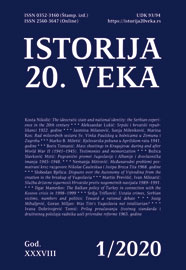PRILOG PROUČAVANJU ŽIVOTNOG STANDARDA I DRUŠTVENOG POLOŽAJA RADNIKA UOČI PRIVREDNE REFORME 1965.
CONTRIBUTION TO THE RESEARCH OF STANDARD OF LIVING AND SOCIAL POSITION OF WORKERS ON THE EVE OF THE ECONOMIC REFORM IN 1965
Author(s): Ivana Dobrivojević TomićSubject(s): Economic history, Political history, Social history, Post-War period (1950 - 1989)
Published by: Institut za savremenu istoriju, Beograd
Keywords: Yugoslavia; Workers; Standard of Living; Social Position; Self-Management;
Summary/Abstract: The 1961 economic reform paved the way for a more rapid social stratification. Society was becoming more and more consumer oriented, shops were full of goods but the poorest social strata spent most of their income on food and housing. The economic liberalization marked the end of the egalitarian wage-levelling, but also the beginning of growing social divisions between workers and administrators, even if they formally had the same level of education. Very low salaries of 50% of all employed workers, a housing-allocation policy, low child subventions, and the social marginalization of industrial workers were among the main motives that encouraged dissatisfied citizens to write to Tito and ask: “Is it still possible to live under these conditions?” and “why is such a policy being implemented in a socialist country?”. Dissatisfaction with the standard of living spread across all pores of society and the communists were told that they were “incompetent” to resolve the accumulated social problems. In such an atmosphere, worker strikes became a means for improving the financial position and working conditions. The results of the economic reform (1965) were modest. Social stratification continued and the economy entered into a phase of stagnation. Agricultural production was declining, and industrial growth was insufficient to prevent Yugoslavia from lagging behind the Western European economies. Unemployment was rising and structural problems were becoming more and more visible. In 1970, in order to maintain the standard of living, the authorities once again froze prices. Despite the efforts made to stabilize the economy, the economic and political crisis became even more manifest.
Journal: Istorija 20. veka
- Issue Year: 2020
- Issue No: 1
- Page Range: 249-272
- Page Count: 24
- Language: Serbian

